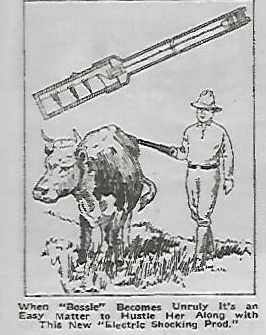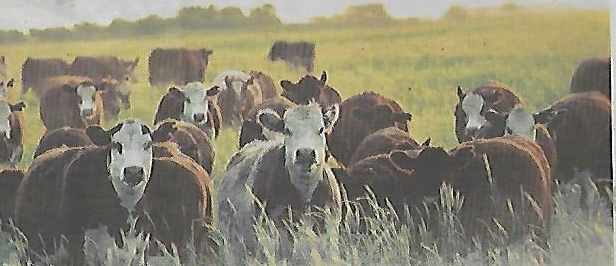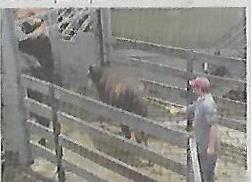An ad from 1917

For many generations and up to present times, our foremost poskim had to deal with the demand of the various governments to halt shechita according to Halochoh, which was termed "the decree against shechita." Often the authorities called for stunning livestock before the slaughter by electric shock, as is done by gentiles, while poskim are convinced that the shock is not a step towards the shechita and killing the animal, but it directly causes the death of the animal.
Pressure is mounting in various countries to implement the shock procedure due to the demands of organizations against animal cruelty. This has brought certain communities to try to find a less drastic solution of a weaker stunning with a lower electric voltage, so as to placate the authorities as well as the organizations to help animals.
Over a century ago, Dr. Shlomo Lieben, an expert physician from Prague, attempted the shock treatment with lesser voltage to bring animals to a prone position so that the shock would not cause the animal to be treif. But his experiments only proved that shock treatment of even minimal electric current could not avoid a serious danger of treifos.
Similar experiments were tried in many countries throughout Europe, the results being altogether the same. The opinion of the author of "Sridei Eish", who originally leaned towards allowance of stunning animals, later retracted.
For all purposes, all poskim throughout the world have forbidden this procedure in any way or form.

However lately in South American countries, where the cattle are very untamed since they are raised in wild and freely roaming conditions, they have begun using electric prods to cause the animals to go from the barn to the slaughter booth in a relatively easier manner.
There are really two entirely separate issues in the shechita procedure but both to do with administering electric shocks to the animals.
Many people out of various motives, try to force the animals to be electrically stunned before being slaughtered, believing or at least arguing that this is a more humane way of slaughtering than just severing the animal's neck. Studies and experts and rabbonim have shown throughout the years that in fact the shechita method is the most human way and involved much less pain and discomfort for the animal than an electric shock strong enough to stun it.
There is another issue that has no ideological component but is purely practical. Generally the animals are kept in buildings or pens that are 100-200 meters away from the actual slaughtering area. The animals must walk this distance from the place they are kept to the place they are slaughtered and in most places non-Jewish workers must see that the animals go the distance. There is pressure on them to do it quickly because "time is money" and there are quotas on how many animals must be killed per hour and per day. Some animals are reluctant to walk the walk, and the workers must overcome their reluctance. This is especially true in South America where the animals are generally more unruly than other places. The best known way to get the animals to go is to use a high powered electric prod.
The workers make a lot of use of their prods, high-powered or not. They can give each animal as many as 15 shocks, and they can be anywhere on its body. The electric shock prod works nonstop. They usually want to kill 100 animals an hour though in some places it can be as many as 140 an hour.
Shocking a reluctant cow

With nothing more than a 12 volt shock, it can get very hard to get the cows to move. The workers have an interest in being able to give stronger shocks. They know how to fool the mashgichim into thinking that they are using 12 volt shockers, which they later juice up to several times that amount.
Another point is that as the animal approaches the slaughter cubicle it is washed, leaving it dripping wet. When the animal is wet, the shocks have a much greater effect.
Regarding heavy electric shock treatment, all experts are unanimous in their clear-cut opinion, as quoted by eminent rabbonim and recognized authorities in the field of shechita. We quote the essence of the words of HaRav Yisroel Meir Levinger, a Rav and foremost shechita and kashrus expert, also a noted veterinarian and Doctor of Zoology, who served as a rabbi in Basel and Munich. He is also the author of many works on Kashrus, with no one challenging his expertise either in Halacha, zoology or veterinary.
During the period he served in Switzerland, where kosher slaughter has long been forbidden, he thoroughly examined this issue in a most professional way, from the halachic aspect, as well as from the anatomical and physiological aspects of kosher shechita. His doctoral thesis, which dealt with this subject, was supervised by professors of anatomy and physiology, neither of them Jewish, who admitted to him that Jewish slaughter does not involve animal cruelty. He paper also dealt with stunning animals before the slaughter from all aspects of the issue.
We cannot quote here the entire scope of this vast subject, but we shall bring the summary and main points on the subject and the practical reservations involved in the stunning process, as he presented in a big essay.
1. The fear of a falling animal: The sudden application of a strong electric current causes the animal to fall to the ground with force, which can cause damage to internal organs as happens from a fall from a roof top, which is discussed in halochoh. The electric shock is also to affect the muscles and might directly cause damage to inner organs comparable to a fall.
2. Suspected treif injury to the brain: When the brains of animal were examined post shechita, water was found between the upper layer and the lower one and the brain itself. Points of blood were also found in the cerebral tissue itself. When the brain was dissected, more blood was also found. The gray matter also showed changes: it was sticky and dissolved.
3. Suspected signs of treif in the lungs: The [sirchos] above the lung were torn in such a manner that they couldn't be checked any more. It was also found that the blood vessels within the lung were also torn, a direct result of the electricity which causes difficulty in the animal's breathing and damage to the lung.
4. Blood absorbed in the organs: During the slaughter of animals stunned beforehand, it was found that the blood does not spurt forth with its usual force but in a much slower stream. This blood is also much darker in color, while the animal's flesh takes on a greenish tinge, all of which shows that the electric shock causes asphyxiation which, in turn, prevents the blood from issuing forth in a heavy stream.
5. When the intestines were examined, blood bubbles were found therein.
6. Blood was also found in the flesh of the cardiac muscle, showing that the electric current caused the heart to weaken.
HaRav Levinger presents all of his doubts and fears arising from the application of electric shock to the animal and cogently explains this. He also brings many tests and examinations on the effect of an electric current upon the body.
In light of these facts, he summarizes the halachic reservations regarding animals stunned before the slaughter.
1. Suspicion of being in danger (mesukennes).
2. Suspicion of treifos based on the fact that after the shock the animal could not live much longer.
3. Suspicion of treifos because of damage in the animal's organs.
4. Suspicion of treifos from the fall of the animal
5. Suspicion of disintegration of the brain from the electric shock.
"The laws of treifos are very stringent and the subject of kashrus is one of the very foundations of Judaism. The decree of animal stunning is a harsh one which endangers the very underpinnings of kashrus for the entire nation which has always sacrificed itself in preserving kashrus in its purity. Heaven forfend that any person rule otherwise individually. This matter has been entrusted to the foremost poskim of our generation, from whose words we shall not budge by even an iota."
*
We have clearly stated that there are no doubts regarding the prohibition of stunning animals with a strong shock before slaughter, and emphatically brought the unanimous opinion of all the eminent poskim of the present and past generations. Still we must relate to the situation in South American countries where cattle roam wild, and gentile slaughterhouse workers use electric battery powered prodders to guide animals from one cubicle to the slaughter place, which can render them treif.
At this point we must stress the significant difference between alternate and direct current. In most countries of the world, electricity supplied to homes is of the alternating type, AC, whereas that used by battery operated prodders is of the direct type, DC. With AC, a quick shock of 230 volts can cause cardiac arrest and instant death in a human, while a battery operated rod releasing direct current will not cause instant death unless it is applied to the back of an animal or person for at least two minutes or more.
An additional, very important detail relevant to our situation is that while a regular battery operates on 1.5 volts, when several are connected in series, the voltage is that much greater. An electric current transformer can also increase the voltage tremendously by hundreds if not thousands of volts. If such a bar is laid upon an animal's back for some time, it will surely cause the animal's death. If for only a short while, it will surely cause internal damage.
In an interview with Chief Rabbi Dovid Lau in order to examine the regulations which were in effect during his tenure as president of the Moetzes HaRabbanut HaRashit and responsible for kashrus, he told us how, four years ago, during a visit he made to slaughterhouses abroad, he learned that such an electric stunner was being used with a higher voltage than what the Chief Rabbinate was allowing (a mere 12 volts), and upon one occasion, he even ordered the entire shechita of that particular day disqualified when he saw that it involved a greater power than what was permissible.
*
As we noted, we have receive information that the situation in practice is very serious, and electric prods are used with a force much greater than permitted, despite the efforts of Chief Rabbi Lau more than a year-and-a-half ago.
Part of the letter of the Chief Rabbi

We also have an official letter written by HaRav Chaim Lasri, the head of the Rabbinate's Division of Foreign Slaughter, to Chief Rabbi Yitzchak Yosef, who is now in charge of these areas. The answer to this letter by the Chief Rabbi is dated 14 Kislev 5779. It tells much about the position of the rabbonim and the actual facts on the ground.
The letter reads (in part) as follows:
"With regard to your first question, about the permissibility of using an electric shocker (prod) in the slaughterhouses in chutz la'aretz, with unruly animals like in Brazil and similar places, where there is a need for an electric prod that moves the animal from a powerful shock towards the slaughter cubicle, and the orders of the Chief Rabbinate in place for a number of years to the head of the shochtim team, not to use an electric prod, and to use only an instrument that has a battery that is not stronger than 12 volts.
"However we note that in practice this is not fulfilled, and in most cases they use a powerful prod without the knowledge of the head of the shochtim team, and there is no way for the head of the shochtim team to ensure compliance since getting the animals into the shechita cubicle is accomplished outside of the shechita room by non-Jewish workers.
"Moreover, even when using a instrument with a battery, one can use a transformer to produce a tremendously powerful charge. Thus, even those who use an instrument with a battery it is probable that the shock produced is of the same power as one produced by a prod that is plugged in."
HaRav Yosef quotes various halachic authorities including HaRav Eliashiv zt"l, HaRav Shlomo Zalman Auerbach zt"l and his father HaRav Ovadia Yosef zt"l who all affirmed this halochoh.
In summary, "The conclusion is that it is absolutely prohibited to shock an animal with electricity before he slaughter, because it creates a possibility of neveila and/or treifa, as we see from all the gedolei haposkim, however if one uses only a small shock (12 volts) to cause the animal to walk to the slaughter (after it stops walking out of fear) then one may be lenient."
If one asks anyone who works in the field they all say that "by them everything is fine." But this is not always the case in practice.
At work in Argentina

A senior official of one of the mehadrin agencies told us: "It is very important that your report will be published. Even we and everyone who works in this area, need an electric shock to get us to check and make sure about what is actually going on with getting the animals to walk. This must be done not only at the beginning of the day, but throughout the day by the mashgiach team. There needs to be a permanent supervisor to make sure that the goyim who herd the animals have not switched the 12 volt prods for others that are much stronger."
One worker told us that if a head of the shochtim team tries to check too much and complains about things like using a high powered electric prod, he could lose his position as the head of the shochtim team since he will slow the work down and lower productivity.
*
To summarize it should be stressed that the problem is not confined to the meat of the Chief Rabbinate, but it is an issue in many other supervised shechitas. From our work and research, it seems that there is no way to allow workers to use an electric shock prod unless there is a mashgiach who supervises them constantly, throughout the day, and along the whole way from the pens to the slaughterhouse, to make sure that they do not use a forbidden shocker.
As far as I know, this arrangement is not implemented by anyone.




